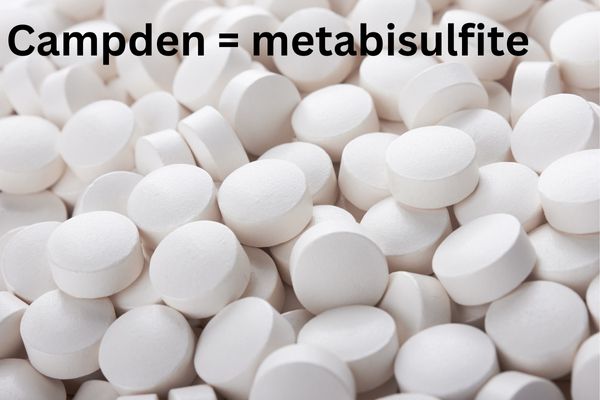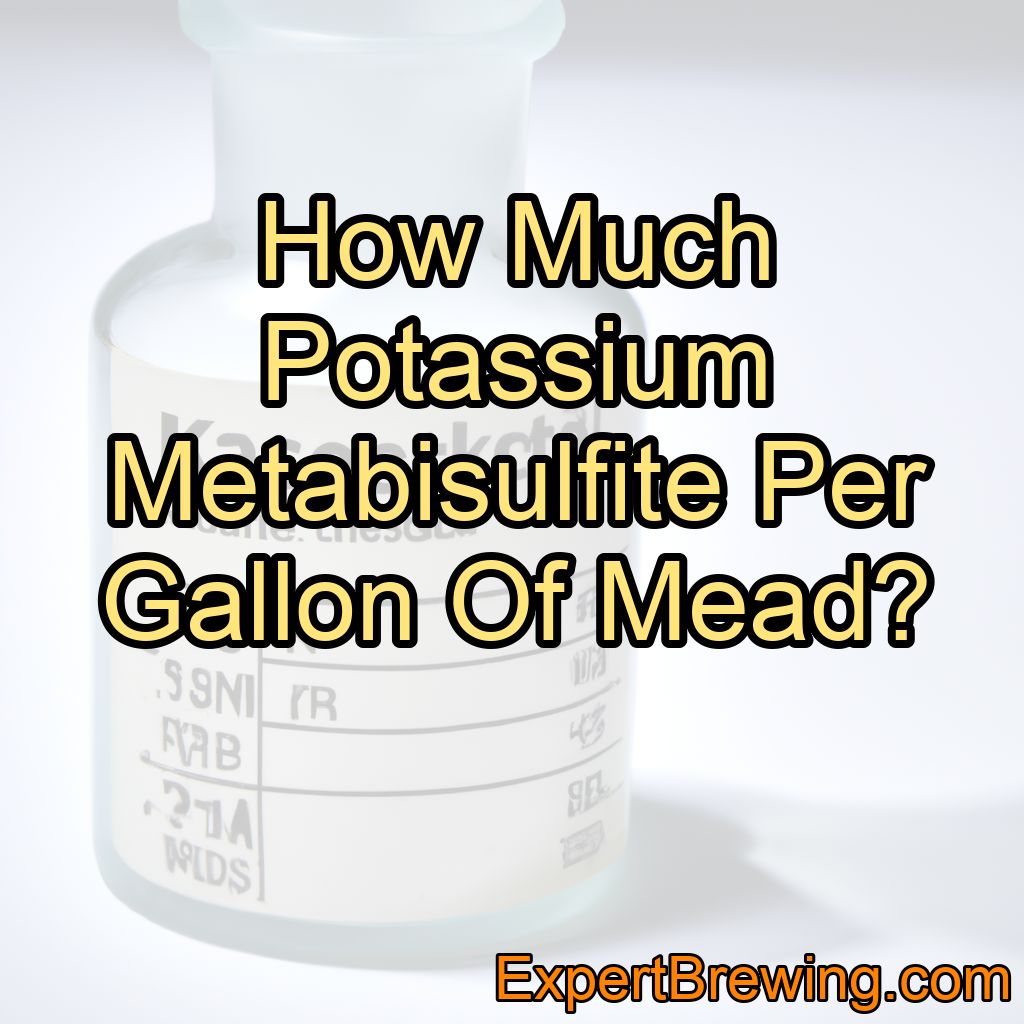As a brewer with years of experience, I’ve had my fair share of questions about the different ingredients and processes involved in creating the perfect batch of mead.
One of the most common questions I get is: how much potassium metabisulfite per gallon of mead do I need?
In general, you should add about 1/4 teaspoon of potassium metabisulfite per five gallons of mead.
This is, if you have not added anything to change the pH of the mead from the average of 3.7 to 4.0. If fruit juice is added, less sulfites need to be added.
That’s around 50 parts per million (ppm). However, the exact amount can vary depending on a variety of factors, including the quality of your honey, the age of your mead, and your personal taste preferences.
Understanding the Role of Potassium Metabisulfite in Mead
What is Potassium Metabisulfite?
Potassium metabisulfite, often abbreviated as K-meta, is a common additive used in winemaking and brewing. It acts as a preservative and antioxidant.
Adding it to your mead helps to prevent oxidation, which can cause off-flavors and spoilage.

It also acts as a disinfectant, killing off unwanted bacteria and wild yeasts that could interfere with your fermentation.
Why Use Potassium Metabisulfite in Mead?
The primary reason to use potassium metabisulfite in mead is to protect your brew from oxidation and spoilage. Mead, like wine, can benefit from some aging.

However, over time, exposure to oxygen can lead to the formation of off-flavors. By adding potassium metabisulfite, you can help preserve the flavor and aroma of your mead, allowing it to age gracefully.
How Much Potassium Metabisulfite to Use in Mead
The general rule of thumb is to use about 1/4 teaspoon of potassium metabisulfite per five gallons of mead, or about 50 ppm. However, this is just a guideline. The exact amount can vary depending on a variety of factors.
Factors Affecting the Amount of Potassium Metabisulfite Needed
Several factors can influence how much potassium metabisulfite you need to add to your mead. One of the most important is the quality of your honey. High-quality honey is less likely to be contaminated with bacteria or wild yeast, reducing the need for potassium metabisulfite.
The age of your mead can also influence how much potassium metabisulfite you need to add. Older meads may require a bit more K-meta to prevent oxidation.
pH is very important
The amount of potassium metabisulfite needed depends on the pH level of your mead.
Therefore it is important to measure the pH accurately before adding any types of sulfites.
For low pH levels (less than 3.5), 1-2 campden tablets per gallon will do the trick – this corresponds to 0.44-0.88 grams of metabisulfite per liter of liquid.
If your liquid has a higher pH (>3.5), you’ll need more – up to 3-4 campden tablets or 1.32-1.76 grams per liter should do the job in this case too!
| pH | Grams KMS/SMS | No. of campden tablets (per gallon) |
| 3 or lower | 0-0.2 | 0-0.5 |
| 3.1 | 0.44 | 1 |
| 3.2 | 0.7 | 1 |
| 3.3 | 0.88 | 2 |
| 3.4 | 1 | 2 |
| 3.5 | 1.2 | 2 |
| 3.6 | 1.32 | 3 |
| 3.7 | 1.5 | 3 |
| 3.8 | 1.76 | 4 |
| >4 | Adjust pH! | Adjust pH! |
An overview of the typical amount of campden used for your (fruit) mead.
If you pH is lower than 3, chances are that you will not need to add campden at all as the acid is enough to keep microorganisms at bay.
It’s important not to add too much potassium metabisulfite, however, as it can lead to off flavors in your beverage if overdone!
That is, your personal taste preferences can also play a role. Some people find that too much potassium metabisulfite can impart a slight sulfurous taste to the mead. If you’re sensitive to this flavor, you may want to use a bit less.
Using Potassium Metabisulfite Safely
While potassium metabisulfite is generally safe to use in brewing, it’s important to handle it with care. Always measure accurately to avoid adding too much, and consider wearing gloves and a mask when handling the powder to prevent skin and respiratory irritation.
Conclusion
Potassium metabisulfite is a valuable tool in the brewer’s arsenal, helping to preserve the flavor and aroma of your mead while preventing spoilage. While the exact amount needed can vary, a good rule of thumb is to use about 1/4 teaspoon per five gallons of mead.
As with any aspect of brewing, the key is to experiment and find what works best for you. Always remember to handle potassium metabisulfite safely and enjoy the process of crafting your perfect batch of mead.
10 Fast Facts about Potassium Metabisulfite in Mead
1. Potassium metabisulfite is a common additive in mead and winemaking.
2. It acts as a preservative and antioxidant.
3. Potassium metabisulfite protects mead from oxidation and spoilage.
4. The general rule of thumb is to use about 1/4 teaspoon per five gallons of mead.
5. The exact amount can vary depending on the quality of your honey, the age of your mead, and your personal taste preferences.
6. High-quality honey is less likely to be contaminated, reducing the need for potassium metabisulfite.
7. Older meads may require more potassium metabisulfite to prevent oxidation.
8. Too much potassium metabisulfite can impart a slight sulfurous taste to the mead.
9. Always handle potassium metabisulfite safely, considering gloves and a mask to prevent irritation.
10. Potassium metabisulfite is a valuable tool in brewing, but the key is to experiment and find what works best for you.
FAQs
How much metabisulfite to add to mead?
The amount of metabisulfite to add to mead depends on the specific recipe and desired outcome. As a general guideline, you can add 1/4 teaspoon (1.25 grams) of potassium metabisulfite per 5 gallons (19 liters) of mead to inhibit microbial growth and preserve the quality. However, it is crucial to follow a reliable recipe or consult with a knowledgeable mead maker to determine the appropriate amount for your specific batch.
How much potassium sorbate for 1 gallon of mead?
The recommended amount of potassium sorbate for 1 gallon of mead is typically 1/2 teaspoon. This is to prevent any further fermentation and stabilize the mead.
How much sodium metabisulfite per gallon of mead?
The recommended amount of sodium metabisulfite in mead is typically 1/4 teaspoon per 5 gallons. This equates to roughly 1/20th of a teaspoon per gallon. It’s important to note that sodium metabisulfite should be used sparingly and with caution, as excessive amounts can impact the taste and quality of the mead.
How much metabisulfite per gallon of water?
The amount of metabisulfite needed per gallon of water depends on the specific application. In winemaking, for example, a common dosage is 1/4 teaspoon (approximately 1.25 grams) of potassium metabisulfite per 5 gallons of wine. However, it is crucial to follow the recommended guidelines provided by the manufacturer or consult a professional for precise instructions based on your specific needs.
How do you add potassium metabisulfite to mead?
To add potassium metabisulfite to mead, you can follow these steps:
1. Measure the required amount: Determine the appropriate dosage of potassium metabisulfite based on the volume of mead you are treating. Generally, a common dosage is 1/4 teaspoon (1.2 grams) per 5 gallons (19 liters) of mead.
2. Dissolve in water: Dissolve the measured amount of potassium metabisulfite in a small amount of water. Use clean, chlorine-free water to avoid any unwanted reactions.
3. Stir gently: Slowly add the dissolved potassium metabisulfite solution to your mead while gently stirring. This helps distribute the sulfite evenly throughout the mead.
4. Wait before bottling: Allow the mead to sit for at least 24 hours after adding the potassium metabisulfite. This waiting period allows the sulfite to react and dissipate any excess gases before bottling.
Remember, potassium metabisulfite is used as a preservative and to inhibit the growth of unwanted microorganisms. It is important to follow proper dosage guidelines and maintain good sanitation practices when working with additives in mead production.
How much campden tablet for 1 gallon of mead?
For 1 gallon of mead, it is generally recommended to use 1 campden tablet. Campden tablets are typically used to prevent oxidation and inhibit the growth of unwanted microorganisms in the fermentation process.




